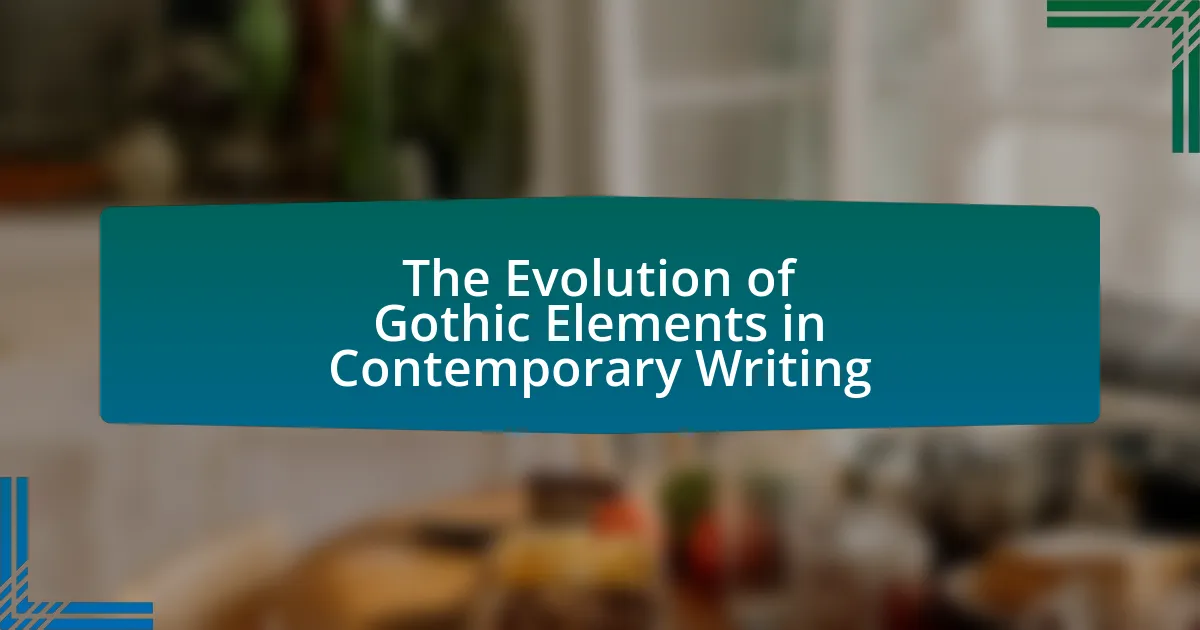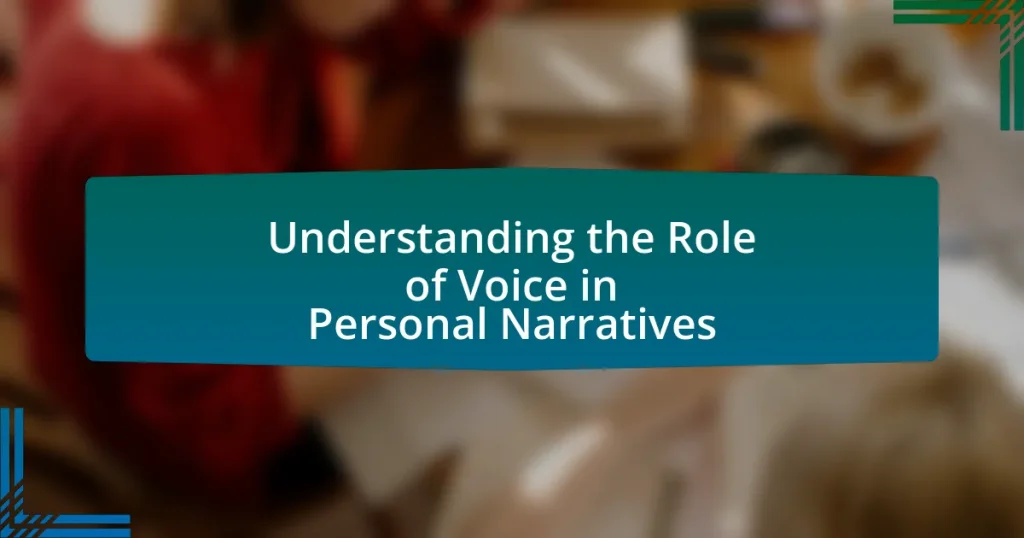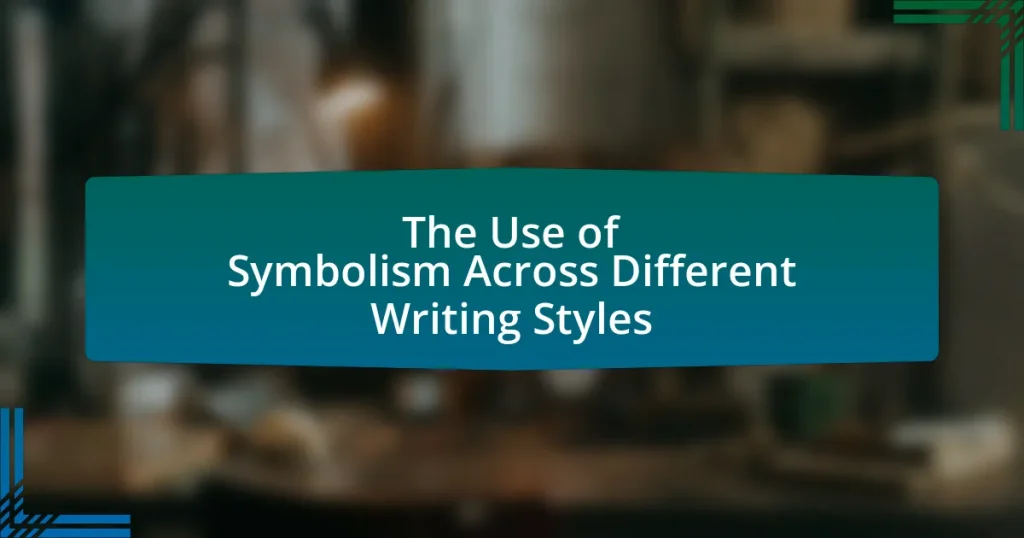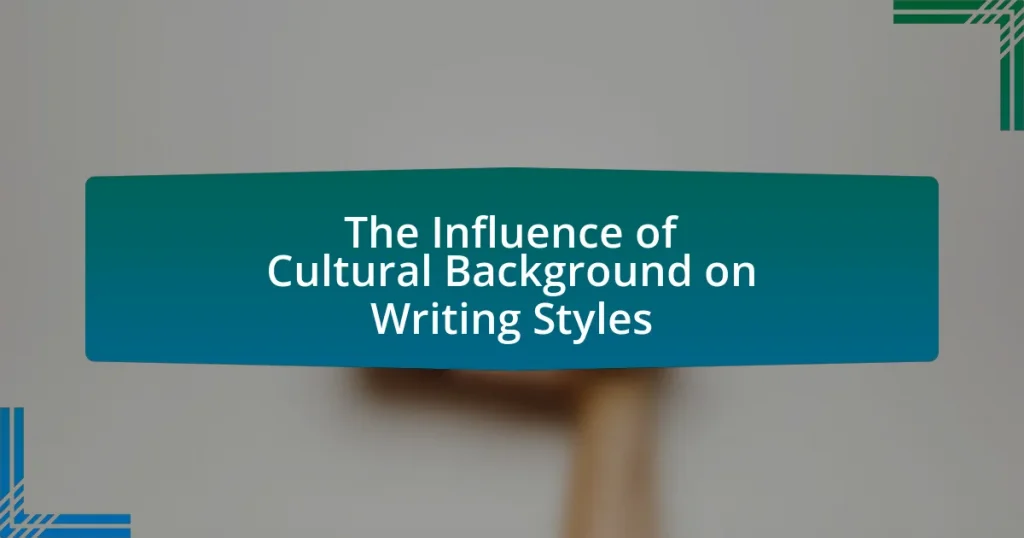The article examines the evolution of Gothic elements in contemporary writing, highlighting their origins in 18th-century literature and their significance in shaping various literary genres. It outlines key characteristics of early Gothic literature, the contributions of pioneering authors, and the thematic explorations that emerged over time. The discussion includes how Gothic elements have adapted to reflect modern societal issues, the techniques authors use to engage contemporary audiences, and best practices for incorporating these elements into writing. Additionally, it addresses common pitfalls to avoid when blending Gothic motifs with other genres, emphasizing the ongoing relevance of Gothic literature in today’s literary landscape.
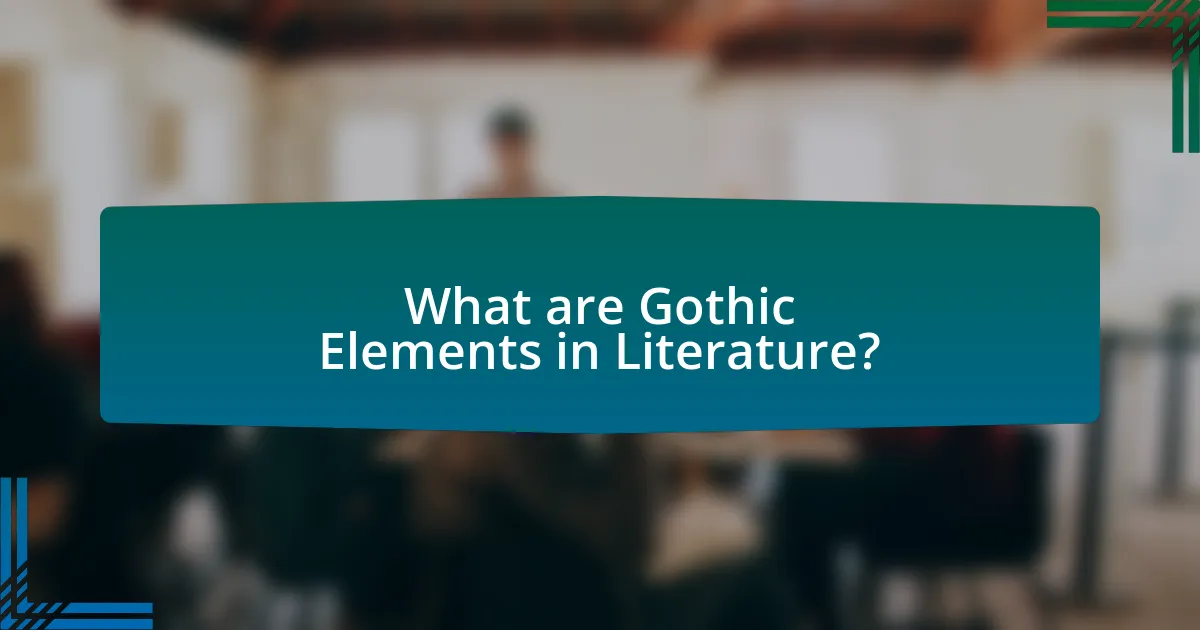
What are Gothic Elements in Literature?
Gothic elements in literature are characteristics that evoke a sense of horror, mystery, and the supernatural. These elements often include dark settings, such as decaying castles or haunted houses, which create an atmosphere of dread. Additionally, themes of isolation, madness, and the uncanny are prevalent, often featuring protagonists who confront their fears or face moral dilemmas. The use of supernatural occurrences, such as ghosts or monsters, further enhances the eerie tone. Historical context shows that Gothic literature emerged in the late 18th century, with works like Horace Walpole’s “The Castle of Otranto” laying the groundwork for these elements.
How did Gothic Elements originate in early literature?
Gothic elements originated in early literature during the late 18th century, primarily through the emergence of the Gothic novel genre. This genre was characterized by its use of dark settings, supernatural occurrences, and an exploration of human psychology, as exemplified by Horace Walpole’s “The Castle of Otranto,” published in 1764, which is often cited as the first Gothic novel. The popularity of this genre was further solidified by works such as Mary Shelley’s “Frankenstein” and Bram Stoker’s “Dracula,” which incorporated themes of horror, mystery, and the sublime, reflecting societal anxieties of the time. These early Gothic narratives laid the foundation for the thematic and stylistic elements that would evolve and influence contemporary writing.
What are the key characteristics of early Gothic literature?
Early Gothic literature is characterized by its focus on the supernatural, an atmosphere of horror, and an exploration of human psychology. These works often feature dark, medieval settings, such as castles or ruins, which create a sense of isolation and dread. Additionally, early Gothic literature frequently includes elements of mystery and the uncanny, often involving ghosts, monsters, or otherworldly beings that challenge the boundaries of reality. Notable examples, such as Horace Walpole’s “The Castle of Otranto” (1764) and Ann Radcliffe’s “The Mysteries of Udolpho” (1794), exemplify these characteristics through their intricate plots and emotional depth, reinforcing the genre’s emphasis on fear and the exploration of the human condition.
Which authors are considered pioneers of Gothic Elements?
The authors considered pioneers of Gothic elements include Horace Walpole, Ann Radcliffe, and Edgar Allan Poe. Horace Walpole’s “The Castle of Otranto,” published in 1764, is often credited as the first Gothic novel, establishing key themes such as supernatural occurrences and dark, medieval settings. Ann Radcliffe further developed these elements in her works, particularly in “The Mysteries of Udolpho,” where she combined psychological depth with atmospheric tension. Edgar Allan Poe is renowned for his contributions to Gothic literature through his short stories and poems, such as “The Tell-Tale Heart” and “The Raven,” which explore themes of madness and death, solidifying the genre’s influence on later writers.
Why are Gothic Elements significant in literary history?
Gothic elements are significant in literary history because they introduced themes of horror, the supernatural, and psychological complexity, which have influenced various literary movements. Originating in the 18th century with works like Horace Walpole’s “The Castle of Otranto,” Gothic literature established a framework for exploring human fears and societal anxieties. This genre paved the way for later developments in Romanticism and Modernism, as seen in the works of authors such as Edgar Allan Poe and Mary Shelley, who incorporated Gothic motifs to delve into the darker aspects of human nature and existence. The enduring presence of Gothic elements in contemporary writing, evident in genres like horror and psychological thrillers, underscores their foundational role in shaping narrative techniques and thematic explorations in literature.
How have Gothic Elements influenced various literary genres?
Gothic elements have significantly influenced various literary genres by introducing themes of horror, the supernatural, and psychological complexity. These elements have permeated genres such as horror, romance, and even science fiction, creating a rich tapestry of narrative possibilities. For instance, the use of dark settings and eerie atmospheres in horror literature can be traced back to Gothic novels like Mary Shelley’s “Frankenstein” and Bram Stoker’s “Dracula,” which established foundational tropes that continue to resonate in contemporary works. Additionally, the exploration of the human psyche, as seen in Gothic literature, has shaped psychological thrillers, where characters often grapple with inner demons and moral ambiguity. This influence is evident in modern authors like Stephen King and Neil Gaiman, who incorporate Gothic motifs to enhance tension and emotional depth in their narratives.
What themes are commonly explored through Gothic Elements?
Gothic elements commonly explore themes of isolation, madness, the supernatural, and the conflict between reason and emotion. Isolation is often depicted through settings like decaying mansions or remote landscapes, reflecting characters’ psychological states. Madness frequently manifests in characters who struggle with their sanity, highlighting the fragility of the human mind. The supernatural introduces elements such as ghosts or monsters, symbolizing fears and societal anxieties. Additionally, the conflict between reason and emotion illustrates the tension between rational thought and primal instincts, often leading to tragic outcomes. These themes are prevalent in works by authors like Edgar Allan Poe and Mary Shelley, who utilized Gothic elements to delve into the darker aspects of human experience.
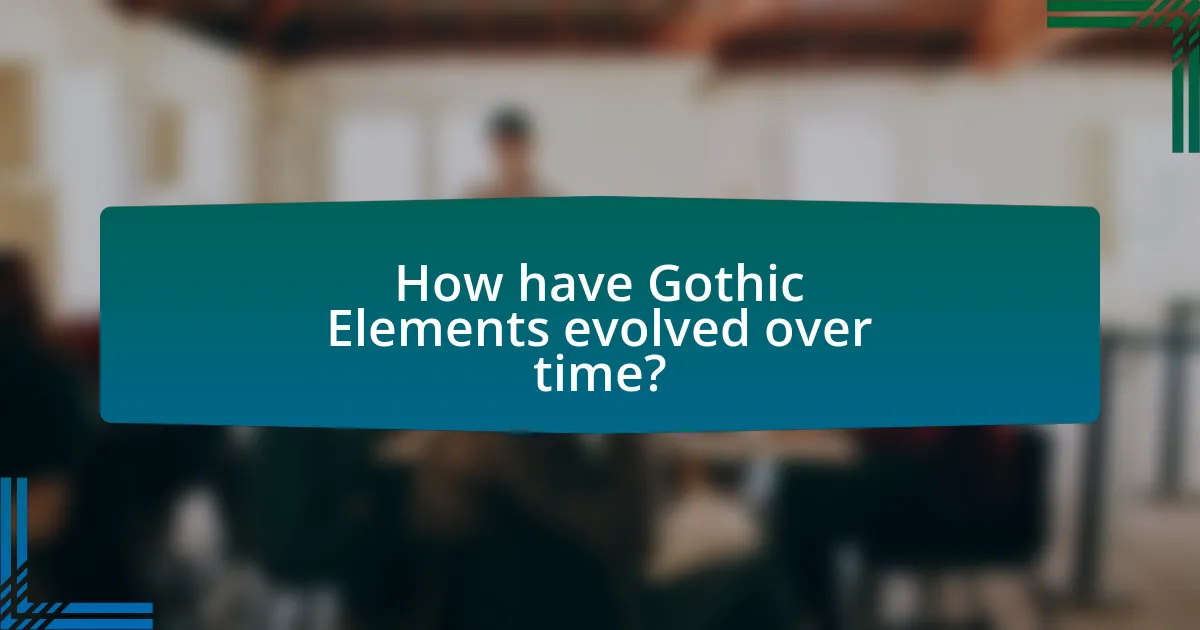
How have Gothic Elements evolved over time?
Gothic elements have evolved from their origins in 18th-century literature to encompass a broader range of themes and styles in contemporary writing. Initially characterized by dark settings, supernatural occurrences, and psychological horror, Gothic literature has transitioned to include elements of psychological realism, social commentary, and diverse cultural influences. For example, modern works often blend traditional Gothic motifs with contemporary issues such as identity, trauma, and societal fears, as seen in novels like “Mexican Gothic” by Silvia Moreno-Garcia, which incorporates cultural heritage into the Gothic framework. This evolution reflects changing societal values and the adaptability of Gothic elements to resonate with current audiences.
What changes occurred in Gothic Elements during the 19th century?
During the 19th century, Gothic elements evolved significantly, transitioning from the traditional medieval settings and supernatural themes to more psychological and emotional dimensions. This shift is exemplified in works such as Mary Shelley’s “Frankenstein” (1818) and Edgar Allan Poe’s stories, which emphasized the inner turmoil of characters and explored themes of isolation and madness rather than solely relying on external horrors. The incorporation of industrialization and urban settings also marked a departure from the classic Gothic architecture, reflecting societal changes and anxieties of the time. This evolution in Gothic literature highlighted a deeper exploration of human psychology and societal issues, making it more relevant to contemporary readers.
How did the Victorian era reshape Gothic literature?
The Victorian era reshaped Gothic literature by introducing psychological depth and social commentary into the genre. This period saw authors like Bram Stoker and Mary Elizabeth Braddon incorporate complex characters and moral dilemmas, reflecting societal anxieties about class, gender, and sexuality. For instance, Stoker’s “Dracula” not only features supernatural elements but also explores themes of fear and desire, mirroring Victorian concerns about modernity and the unknown. Additionally, the era’s fascination with the macabre and the uncanny led to a proliferation of Gothic tropes, such as the haunted house and the Byronic hero, which became staples in later literature.
What new themes emerged in 19th-century Gothic works?
New themes that emerged in 19th-century Gothic works include the exploration of psychological horror, the impact of industrialization, and the questioning of morality and social norms. Psychological horror became prominent as authors like Edgar Allan Poe delved into the complexities of the human mind, illustrating themes of madness and existential dread. The influence of industrialization is evident in works such as Mary Shelley’s “Frankenstein,” which reflects anxieties about scientific advancement and its ethical implications. Additionally, the questioning of morality and social norms is highlighted in texts like Charlotte Perkins Gilman’s “The Yellow Wallpaper,” where the constraints of gender roles and mental health are critically examined. These themes collectively signify a shift towards a more introspective and socially aware Gothic literature in the 19th century.
How did the 20th century further transform Gothic Elements?
The 20th century transformed Gothic elements by integrating psychological depth, modernist themes, and new narrative techniques. This transformation is evident in works such as Shirley Jackson’s “The Haunting of Hill House,” which emphasizes the psychological terror of its characters, moving away from traditional supernatural elements. Additionally, authors like H.P. Lovecraft introduced cosmic horror, expanding the Gothic genre to include existential dread and the insignificance of humanity in the universe. The use of unreliable narrators and fragmented narratives in modern Gothic literature reflects the influence of modernist literature, further evolving the genre. These shifts illustrate how the 20th century redefined Gothic elements to explore complex human emotions and societal anxieties.
What role did modernism play in the evolution of Gothic literature?
Modernism significantly influenced the evolution of Gothic literature by introducing themes of alienation, fragmentation, and psychological depth. This shift allowed Gothic literature to explore the complexities of the human psyche, moving beyond traditional supernatural elements to incorporate existential dread and societal critique. For instance, authors like Virginia Woolf and Franz Kafka infused Gothic elements with modernist techniques, emphasizing internal conflict and the breakdown of reality. This blending of styles resulted in a more nuanced portrayal of fear and horror, reflecting the anxieties of the modern age.
How did postmodernism reinterpret Gothic Elements?
Postmodernism reinterpreted Gothic elements by subverting traditional narratives and emphasizing fragmentation, irony, and self-reflexivity. This movement transformed the Gothic’s focus on horror and the sublime into a critique of societal norms and cultural constructs, often employing pastiche and intertextuality. For instance, works like Thomas Pynchon’s “Gravity’s Rainbow” and Angela Carter’s “The Bloody Chamber” utilize Gothic motifs to explore themes of identity and power dynamics, showcasing how postmodernism reshapes the emotional and psychological landscapes of the Gothic tradition.
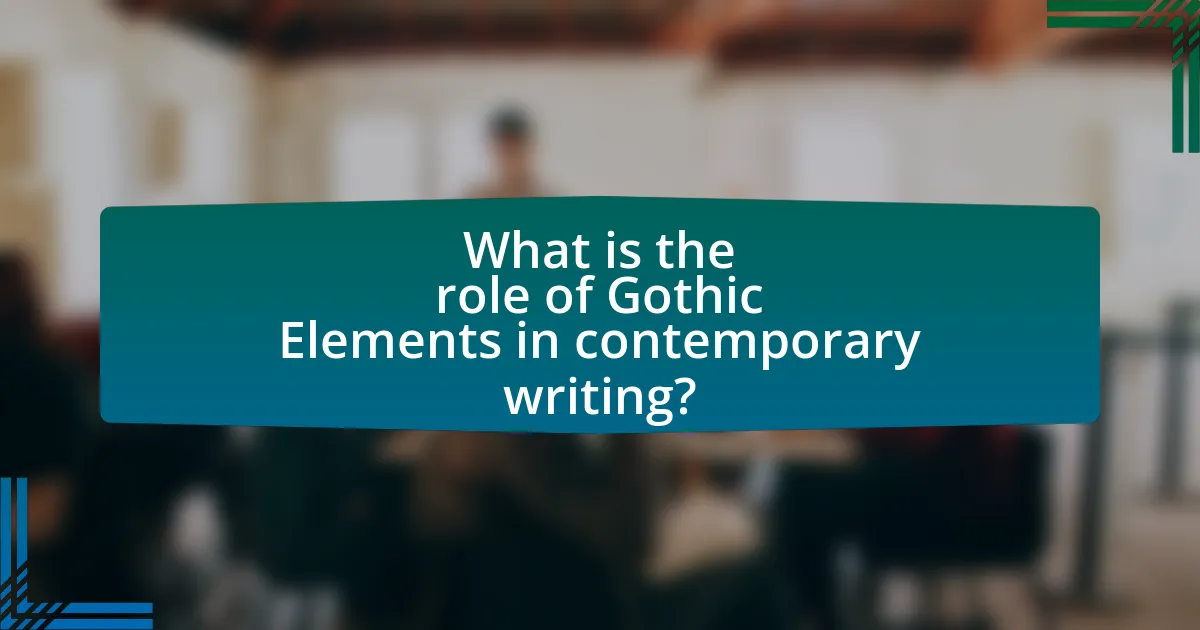
What is the role of Gothic Elements in contemporary writing?
Gothic elements play a significant role in contemporary writing by enhancing themes of psychological complexity, existential dread, and societal critique. These elements, such as dark settings, supernatural occurrences, and complex characters, allow authors to explore the human condition and societal fears in a nuanced manner. For instance, contemporary novels like “Mexican Gothic” by Silvia Moreno-Garcia utilize traditional Gothic motifs to address issues of colonialism and gender, demonstrating how these elements can be adapted to reflect modern concerns. This adaptation of Gothic elements not only preserves their historical significance but also revitalizes them, making them relevant in discussions about identity, trauma, and morality in today’s literary landscape.
How are Gothic Elements utilized in modern literature?
Gothic elements are utilized in modern literature to evoke feelings of horror, suspense, and the supernatural, often through settings, character archetypes, and themes of isolation and madness. Contemporary authors incorporate dark, atmospheric settings reminiscent of traditional Gothic architecture, such as decaying mansions or eerie landscapes, to create a sense of foreboding. Additionally, character archetypes like the tortured hero or the femme fatale are prevalent, reflecting psychological complexities and moral ambiguity. Themes of existential dread, societal decay, and the exploration of the human psyche are also central, as seen in works like “The Silent Patient” by Alex Michaelides, which employs these elements to build tension and intrigue. This modern adaptation of Gothic conventions demonstrates their enduring relevance and adaptability in exploring contemporary issues.
What are some examples of contemporary authors using Gothic Elements?
Contemporary authors using Gothic elements include Silvia Moreno-Garcia, whose novel “Mexican Gothic” incorporates traditional Gothic motifs such as isolation and the supernatural within a Mexican setting. Another example is Tana French, whose psychological thrillers often feature dark atmospheres and complex characters, reflecting Gothic influences. Additionally, Paul Tremblay’s “The Cabin at the End of the World” blends horror with psychological tension, showcasing elements like dread and the uncanny. These authors demonstrate the ongoing relevance and adaptation of Gothic themes in modern literature.
How do contemporary themes reflect societal issues through Gothic Elements?
Contemporary themes reflect societal issues through Gothic elements by utilizing motifs such as isolation, psychological horror, and the uncanny to explore modern anxieties. For instance, the use of decaying settings in contemporary Gothic literature symbolizes societal decay and moral ambiguity, mirroring issues like urban decay and economic disparity. Works like “The Cabin at the End of the World” by Paul Tremblay illustrate how fear and paranoia in a confined space can represent societal fears surrounding safety and community. Additionally, the exploration of identity crises in characters often reflects contemporary discussions on mental health and societal expectations, as seen in novels like “Mexican Gothic” by Silvia Moreno-Garcia, which addresses colonialism and gender roles through its eerie narrative. These Gothic elements serve as a lens to critique and illuminate pressing societal issues, making them relevant in today’s context.
What impact do Gothic Elements have on reader engagement today?
Gothic elements significantly enhance reader engagement today by invoking emotional responses and creating immersive atmospheres. These elements, such as dark settings, supernatural occurrences, and psychological tension, draw readers into a world that stimulates their imagination and evokes feelings of suspense and fear. For instance, contemporary works like “Mexican Gothic” by Silvia Moreno-Garcia utilize traditional Gothic motifs to captivate audiences, demonstrating that these elements remain relevant and effective in modern storytelling. Research indicates that readers are more likely to become emotionally invested in narratives that employ Gothic techniques, as they create a sense of intrigue and anticipation, thereby increasing overall engagement.
How do Gothic Elements enhance emotional responses in contemporary narratives?
Gothic elements enhance emotional responses in contemporary narratives by creating an atmosphere of suspense, fear, and psychological complexity. These elements, such as dark settings, supernatural occurrences, and themes of isolation, evoke strong feelings of anxiety and dread in readers. For instance, the use of decaying mansions or haunted landscapes serves to symbolize internal turmoil, allowing readers to connect emotionally with characters’ struggles. Research indicates that narratives employing Gothic motifs can trigger heightened emotional engagement, as evidenced by studies showing increased physiological responses, such as heart rate and galvanic skin response, during suspenseful scenes. This connection between Gothic elements and emotional intensity underscores their effectiveness in contemporary storytelling.
What techniques do authors use to modernize Gothic Elements for today’s audience?
Authors modernize Gothic elements for today’s audience by incorporating contemporary themes, diverse characters, and psychological depth. They often blend traditional Gothic motifs, such as isolation and the supernatural, with modern issues like mental health, social justice, and technology. For instance, works like “Mexican Gothic” by Silvia Moreno-Garcia recontextualize Gothic horror within a culturally rich narrative, addressing colonialism and gender dynamics. Additionally, authors utilize unreliable narrators and non-linear storytelling to create suspense and engage readers in a more interactive experience. This evolution reflects a shift in societal values and the desire for inclusivity, making Gothic literature relevant and relatable to modern audiences.
What are best practices for incorporating Gothic Elements in writing?
To effectively incorporate Gothic elements in writing, authors should focus on creating an atmosphere of mystery and suspense, utilizing dark settings, and developing complex characters. Establishing a foreboding environment, such as decaying mansions or eerie landscapes, enhances the Gothic tone, as seen in works like “Wuthering Heights” by Emily Brontë, where the moors contribute to the story’s dark ambiance. Additionally, employing themes of isolation and madness can deepen character development, as demonstrated in Edgar Allan Poe’s stories, where protagonists often grapple with their sanity. Utilizing symbolism, such as the use of shadows or supernatural elements, can further enrich the narrative, providing layers of meaning that resonate with readers. These practices align with the historical roots of Gothic literature, which emerged in the 18th century, emphasizing emotional intensity and the exploration of the human psyche.
How can writers effectively blend Gothic Elements with other genres?
Writers can effectively blend Gothic elements with other genres by incorporating themes of horror, decay, and the supernatural while maintaining the structural and stylistic conventions of the primary genre. For instance, in a romance novel, a writer might introduce a haunted setting or a mysterious character with a dark past, creating tension and intrigue that enhances the romantic plot. This technique is evident in works like “The Silent Companions” by Laura Purcell, where Gothic motifs are seamlessly integrated into historical fiction, enriching the narrative without overshadowing the genre’s core elements. By carefully balancing these elements, writers can create a unique fusion that appeals to fans of both Gothic and the primary genre.
What common pitfalls should writers avoid when using Gothic Elements?
Writers should avoid overusing clichés when incorporating Gothic elements. Relying on tired tropes, such as the haunted mansion or the mad scientist, can lead to predictable narratives that fail to engage readers. Instead, writers should strive for originality by developing unique characters and settings that evoke the Gothic atmosphere without resorting to stereotypes. This approach is supported by literary analysis, which indicates that fresh interpretations of Gothic conventions can enhance thematic depth and reader immersion, as seen in works like “Mexican Gothic” by Silvia Moreno-Garcia, where traditional elements are reimagined in a contemporary context.
